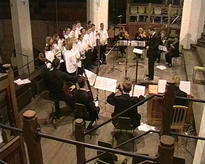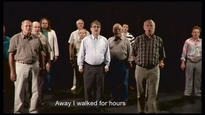CANTEMUS - CHOIRS, THE SUBLIME AND THE EXEGESIS OF BEING
EXHIBITION
The confrontation with the sublime and the exegesis of being provide the thematic substrate of the Cantemus group exhibition. Starting out with the motif of the choir, vocal excerpts from Mozart’s Requiem, the song Brunnen vor dem Tore from Schubert’s Winterreise cycle and Bach’s cantata Herz und Mund und Tat und Leben, the program of the exhibition examines such aspects of life as destiny and divine judgement, sometimes realistically and sometimes ironically.
As a group that embodies the ties between the individual and the community, the choir is a fitting instrument for this. But in this case it is not employed in a traditionally dramaturgical sense, by providing commentary or personifying a collective conscience. In terms of narrative, Guido van der Werve (1977), Sven Johne (1976) and Artur Żmijewski (1966) take an adventurous and experimental approach to choirs and to music as human passion. Such issues as irrationality, the grotesque and the comic play an ingenious part in this.
Allegorical landscapes and the use of the Rückenfigur in Guido van der Werve’s Number four: I don’t want to get involved in this, I don’t want to be part of this, talk me out of it (2005) make it pictorially indebted to Romanticism. But, by inserting unexpected incidents of slapstick, this meditation on death, solitude and the absurdity of life refers just as much to the work of the very prematurely deceased conceptual artist Bas Jan Ader. Sven Johne’s Wissower Klinken (2007) at first allots a prominent place to the voiceover, after which a chorus of twelve nature guides pay tribute to their colleague Klaus Bartels, who was fatally stuck by a falling rock. Since his passing, they have ruminated on the questions ‘Were higher powers involved?’ and ‘Is this wrath or punishment?’ Artur Żmijewski’s Singing Lesson 2 (2003) is all idiosyncratic sublimity. In the Thomaskirche in Leipzig, where Johann Sebastian Bach was appointed cantor and where he is buried, a choir of deaf children performs a cantata. With the accompaniment of professional musicians, this results in a unique combination of cacophony, contrapuntal rigour and perfectly timed ritornellos. As is typical of Żmijewski’s work, this moving social experiment is larded with plenty of societal undertones, such as the church’s historical refusal to give communion to the deaf. For the exhibition, the Slovenian artist Tobias Putrih designed seating for the audience that combines the forms of the ladder and the arena.
As a group that embodies the ties between the individual and the community, the choir is a fitting instrument for this. But in this case it is not employed in a traditionally dramaturgical sense, by providing commentary or personifying a collective conscience. In terms of narrative, Guido van der Werve (1977), Sven Johne (1976) and Artur Żmijewski (1966) take an adventurous and experimental approach to choirs and to music as human passion. Such issues as irrationality, the grotesque and the comic play an ingenious part in this.
Allegorical landscapes and the use of the Rückenfigur in Guido van der Werve’s Number four: I don’t want to get involved in this, I don’t want to be part of this, talk me out of it (2005) make it pictorially indebted to Romanticism. But, by inserting unexpected incidents of slapstick, this meditation on death, solitude and the absurdity of life refers just as much to the work of the very prematurely deceased conceptual artist Bas Jan Ader. Sven Johne’s Wissower Klinken (2007) at first allots a prominent place to the voiceover, after which a chorus of twelve nature guides pay tribute to their colleague Klaus Bartels, who was fatally stuck by a falling rock. Since his passing, they have ruminated on the questions ‘Were higher powers involved?’ and ‘Is this wrath or punishment?’ Artur Żmijewski’s Singing Lesson 2 (2003) is all idiosyncratic sublimity. In the Thomaskirche in Leipzig, where Johann Sebastian Bach was appointed cantor and where he is buried, a choir of deaf children performs a cantata. With the accompaniment of professional musicians, this results in a unique combination of cacophony, contrapuntal rigour and perfectly timed ritornellos. As is typical of Żmijewski’s work, this moving social experiment is larded with plenty of societal undertones, such as the church’s historical refusal to give communion to the deaf. For the exhibition, the Slovenian artist Tobias Putrih designed seating for the audience that combines the forms of the ladder and the arena.



-
zo 29.1.2012
- zo 01.4.2012
-
Praktische info
Location:
Argos
Werfstraat 13 rue du Chantier
1000 Brussels
info@argosarts.org
+32 2 229 00 03
Opening hours:
Wednesday to Sunday, 11:00 to 18:00
Entrance Fee:
5 / 3 euros - Kunstenaars